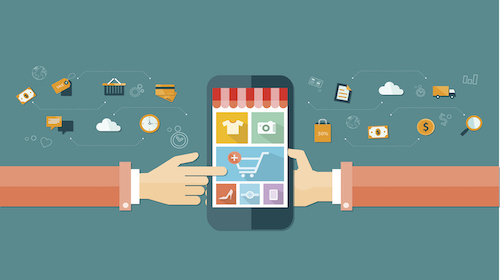To create a contactless engagement strategy, you’ll need a few digital channels (i.e. LinkedIn, Facebook) to get started. If you didn’t prioritise a contactless engagement strategy before the COVID-19 pandemic hit, that’s certainly changed now.
When lockdown measures forced brick-and-mortar shops to close, it led to a seismic shift in ways of doing business. Shoppers no longer felt safe visiting stores and businesses had to find new ways of engaging them. But from necessity comes invention. The crisis moved many companies and their customers towards adopting contactless engagement.
By eliminating touchpoints, contactless engagement minimises health and safety risks when reopening after COVID-19. It can also result in more efficient and innovative ways of operating. Many retailers now offer contactless kerbside service, where a customer orders online, pulls up to a designated spot and has their purchases loaded in by an employee.
Contactless service bar for customers.
Hotels have turned to digital check-in and AI-enabled concierges. Restaurants and grocers have introduced or scaled up contact-free delivery services, allowing them to reach new customers who might have never visited their brick-and-mortar locations.
Other organisations have turned to digital channels to turbo-charge their contactless engagement strategy. In the process, they have discovered exciting new frontiers where customer service doesn’t end when the clock strikes five.
How can businesses follow the lead of these companies and turn the challenges of the current climate into opportunities? And how can they create a contactless engagement strategy across digital channels?
Why digital channels are the cornerstone of a contactless engagement strategy
The challenges posed by the health crisis have been difficult for many businesses to navigate. But the ones that prioritised digital transformation are in better shape to thrive in the New Normal. In fact, using digital channels to support contactless engagement is proving to be transformative for many companies.
Digital channels enable companies to find new customers and to meet their old customers in new places. And when connected, digital channels can provide the framework for seamless customer journeys across different touchpoints.
What are digital channels and why are they so important?
Store closures pushed many traditional brick-and-mortar customers towards e-commerce. Online, they’re experiencing a new world of real-time service, seamless omnichannel shopping, tailored recommendations, and highly personalised communications.
Digital channels are finely tuned to provide users with exceptional experiences. So for many customers, there’s no going back to the old, analogue ways of shopping. This means that to keep up with their competitors, businesses have to optimise their digital channels and provide the online experiences that are now standard.
Today’s customers want to be able to do more than just visit a business’s website. They want to engage with a business across several different digital channels, including:
social media platforms
embedded chat
email marketing
messaging platforms
Anywhere that a business can potentially engage with a customer digitally is an untapped solution. Companies that don’t explore these options will lose out to companies that do.
How to connect digital channels to create a good contactless engagement experience
An omnichannel customer journey enables users to move seamlessly across different touchpoints. This is becoming normalised in the modern world. So connecting digital channels is a must for forward-thinking businesses. Here are some ways to connect digital channels to create an inspiring contactless engagement experience:
Use live chat
In-store assistants are great ways to build rapport with customers, but chats can be just as effective. Live chats aren’t limited by store or office hours, making them a convenient way for businesses to connect with their customers. Creating pre-chat and post-chat surveys can also be a good way to solicit feedback.
Live chat software: Intercom and LiveChat
Turn to AI to personalise content
No one wants to be inundated with messaging that are not relevant to their interests. So offering tailored content is one of the best ways to improve the customer experience. For retailers, this is a golden opportunity to cross-sell and upsell simply by displaying relevant products or services.
AI technologies: Salesforce Einstein and Google AI
Create an omnichannel experience
Establishing and optimising digital channels is great; connecting them is even better. MuleSoft offers businesses an easy way to connect their digital channels. You can even integrate with Sales Cloud and Service Cloud to provide better, more connected experiences for their customers.
Provide flexible digital options
Empowering customers with digital tools will help them create the experience that’s right for them. Lightning Scheduler enables users to create virtual appointments while offering self-service portals that can help businesses cut back on response and resolution time.
Generate interest
It’s important to communicate empathetically in times of crisis. Conversely, it’s also okay to get customers excited about something. Engaging customers on social media platforms and soliciting feedback helps companies build awareness, target new customers, and provide service benchmarks. Social Studio enables businesses to better leverage social-media channels and improve the customer journey.
Create a contactless engagement strategy to thrive in the New Normal
The COVID-19 pandemic created new challenges for businesses around the globe. Ad as we begin to see the effects of the crisis, we also begin to see how businesses have evolved and grown stronger in response. In this new landscape, creating a contactless engagement strategy is key.
To find more actionable info about preparing for the future by adapting to the present, check out the New Retail Playbook today.




